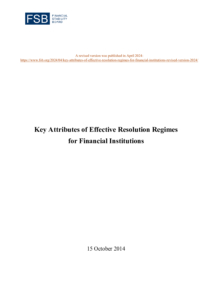This year’s Resolution Report commemorates the tenth anniversary of the FSB Key Attributes of Effective Resolution Regimes for Financial Institutions (“Key Attributes”) which were adopted by the FSB Plenary in October 2011 and endorsed by the G20 at the Cannes Summit in November 2011.
Since their adoption ten years ago, the FSB Key Attributes of Effective Resolution Regimes have set the standard for the reform of resolution regimes and resolution planning across all sectors. While progress towards resolvability has been significant, the FSB´s recent evaluation of the “too big to fail” reforms found that a number of gaps need to be addressed to fully realise the benefits of the resolution reforms. Looking ahead, emerging themes in resolution planning relate to digital innovation, including in relation to reliance on third-party service providers and cloud services and the need to assess resolvability of non-traditional market participants.
-
Banks – Important work remains to improve the resolvability of global systemically important banks. Work continues on allocation of Total Loss-Absorbing Capacity (TLAC) resources within groups, G-SIBs’ capabilities for access to funding in resolution, valuation and continuity of access in resolution to financial market infrastructures (FMIs). Cross-border issues remain to be addressed for instance in relation to funding in resolution and bail-in execution. The FSB will soon publish a practices paper that summarises the issues on the latter.
-
Central Counterparties (CCPs) – Uncertainty remains around the resolvability of CCPs given their systemic role in the financial system. A preliminary analytical report on CCP financial resources will be published in early 2022 and will inform options for potential new or revised international policy on the use, composition or amount of financial resources for CCP recovery or resolution.
-
Insurers – Progress on resolution reforms and resolution planning implementation in the insurance sector has been mixed. As in prior years, some jurisdictions have identified systemically important insurers and/or internationally active insurance groups. Work on resolution planning and resolvability assessments for these institutions has started or is under way. The FSB will soon publish two papers that present practices regarding financial and operational interconnectedness in resolution planning and funding in resolution.
The FSB has also published the data underpinning the Resolution Reform Index which is used in Graph 5 of the Resolution Report. The index illustrates the progress of FSB jurisdictions in adopting comprehensive bank resolution reforms since the global financial crisis. A detailed description of the RRI can be found in Annex F of the March 2021 FSB Report on the Evaluation of Too-Big-To-Fail Reforms.
Datasets from the report are publicly available for use in accordance with the FSB’s normal terms and conditions.
